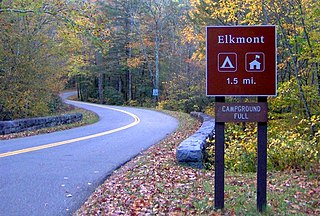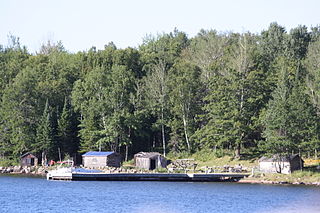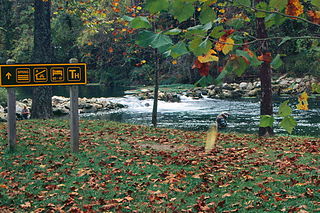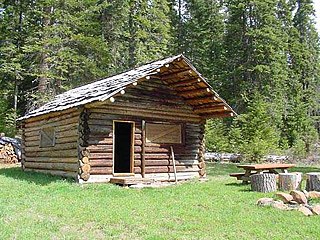
Elkmont is a region situated in the upper Little River Valley of the Great Smoky Mountains of Sevier County, in the U.S. state of Tennessee. Throughout its history, the valley has been home to a pioneer Appalachian community, a logging town, and a resort community. Today, Elkmont is home to a large campground, ranger station, and historic district maintained by the Great Smoky Mountains National Park.

First Landing State Park offers recreational opportunities at Cape Henry in the independent city of Virginia Beach, Virginia. As the first planned state park of Virginia, First Landing is listed on the National Register of Historic Places as Seashore State Park Historic District. A portion of the park is listed as a National Natural Landmark as part of the Seashore Natural Area.

Manitou Camp is a logging and fishing camp started in the 1890s on Manitou Island, part of the Apostle Islands National Lakeshore. Today, as historically, Manitou Camp is used as a campground and as a facility for fishing. It has been listed on the National Register of Historic Places since 1983 and is owned by the National Park Service.

Bennett Spring State Park is a public recreation area located in Bennett Springs, Missouri, twelve miles (19 km) west of Lebanon on Highway 64 in Dallas and Laclede counties. It is centered on the spring that flows into the Niangua River and gives the park its name. The spring averages 100 million gallons of daily flow. The park offers fly fishing, camping, canoeing, hiking, and other activities.

The Fish Cabin at White Rock Shoals is a historic fish cabin near St. James City, Florida.

Backbone State Park is Iowa's oldest state park, dedicated in 1919. Located in the valley of the Maquoketa River, it is approximately three miles (5 km) south of Strawberry Point in Delaware County. It is named for a narrow and steep ridge of bedrock carved by a loop of the Maquoketa River originally known as the Devil's Backbone. The initial 1,200 acres (490 ha) were donated by E.M. Carr of Lamont, Iowa. Backbone Lake Dam, a relatively low dam built by the Civilian Conservation Corps (CCC) in the 1930s, created Backbone Lake. The CCC constructed a majority of trails and buildings which make up the park.

Westmoreland State Park lies within Westmoreland County, Virginia. The park extends about one and a half miles along the Potomac River and covers 1,321 acres. The Horsehead Cliffs provide visitors with a panoramic view of the Potomac River, and lower levels feature fossils and beach access. The park offers hiking, camping, cabins, fishing, boating and swimming, although mechanical issues have kept the swimming pool closed since 2021. Located on the Northern Neck Peninsula, the park is close to historical sites featuring earlier eras: George Washington's birthplace and Stratford Hall, the birthplace of Robert E. Lee.

Rocky Island is one of the Apostle Islands in northern Wisconsin, in Lake Superior, and is part of the Apostle Islands National Lakeshore. Two listings on the National Register of Historic Places are located on the island: Hadland Fishing Camp and the Rocky Island Historic District.

The Giant Forest Village–Camp Kaweah Historic District is located in Sequoia National Park. It is notable as one of two registered historic districts in the park that were largely demolished as part of National Park Service efforts to mitigate the impact of park visitor facilities on the park's giant sequoia groves. They were in a vernacular National Park Service Rustic and American Craftsman Bungalow style.
Roaring River State Park is a public recreation area covering of 4,294 acres (1,738 ha) eight miles (13 km) south of Cassville in Barry County, Missouri. The state park offers trout fishing on the Roaring River, hiking on seven different trails, and the seasonally open Ozark Chinquapin Nature Center.

The Willow Prairie Cabin is a rustic one-room cabin located in the Rogue River-Siskiyou National Forest in western Oregon, United States. It was built by a road construction crew in 1924. When the road was finished the United States Forest Service began using it to house fire crews assigned to patrol the surrounding National Forest. The Forest Service now rents the cabin to recreational visitors. The Willow Prairie Cabin is listed on the National Register of Historic Places.

Biederman's Cabin, also called Biederman's Fish Camp, is a privately owned cabin on the Yukon River in Alaska. Located within the Yukon-Charley Rivers National Preserve, it is maintained as a historic site representing the subsistence lifestyle employed by Interior Alaska residents during the early years of the 20th century and is one of the few structures within the preserve.

The Edisen Fishery is a fishery located in Rock Harbor in the Isle Royale National Park in Michigan. It was designated a Michigan State Historic Site in 1976 and listed on the National Register of Historic Places in 1977.

The Rocky Island Historic District is a historic district in the Apostle Islands in Ashland County, Wisconsin. It is composed of the Hadland, Benson, Edwards, Nelson, and Erickson fish camps, which were located on the eastern shore of Rocky Island. The district represents the historical significance of commercial fishing on Lake Superior, which was primarily conducted by Scandinavian immigrants. The Rocky Island Historic District was added to the National Register of Historic Places on July 3, 2008.
Architects of the National Park Service are the architects and landscape architects who were employed by the National Park Service (NPS) starting in 1918 to design buildings, structures, roads, trails and other features in the United States National Parks. Many of their works are listed on the National Register of Historic Places, and a number have also been designated as National Historic Landmarks.

The Fishing Tug Katherine V., designated US 228069, is a Great Lakes fishing tug. Displayed at the Besser Museum of Northeast Michigan, in Alpena, Michigan, it is believed to be the last intact wooden fishing tug remaining. It was listed on the National Register of Historic Places in 2003.

The Jim Scott Fishhouse is a historic building in Grand Marais, Minnesota, United States, built in 1907 by a family-owned commercial fishing outfit. During the fishing season it served as a place to dress and pack fish, while over the winter it was used for the storage and repair of fishing gear. The Jim Scott Fishhouse was listed on the National Register of Historic Places in 1986 for having local significance in the theme of commerce. It was nominated for being a representative of the important commercial fishing industry on the upper North Shore of Lake Superior.

Bearnstow is a summer camp on Parker Pond in Mount Vernon, Maine. The camp offers weeklong and day programs for adults and children, with an emphasis on appreciation of nature through the arts and sciences. Founded in 1946, the camp occupies 65 acres (26 ha) on the east side of the pond, and is centered on the former Spruce Point Camps, whose facilities, built in the 1920s and 1930s, are listed on the National Register of Historic Places.

The Jim Baker Cabin was built in 1873 by frontiersman Jim Baker as a fortified house on the Little Snake River at Savery Creek near present-day Savery, Wyoming. The two-story log building measures 31 feet (9.4 m) by 16 feet (4.9 m) with two rooms on the lower level and a single smaller room on the upper level. The outer walls are made of logs 12 inches (30 cm) to 15 inches (38 cm) thick.
The CM Ranch and Simpson Lake Cabins are separate components of a single historic district associated with Charles Cornell Moore, a Fremont County, Wyoming dude ranch operator. The CM ranch, named after Moore, operated as a dude ranch from 1920 to 1942 and resumed operating in 1945. The Simpson Lake Cabins were purchased by Moore in 1931 and were operated as a hunting camp, continuing until 1997 when the CM ranch was sold to new owners and the Simpson Lake property was taken over by the U.S. Forest Service.. The sites are separated by 13 miles (21 km).




















